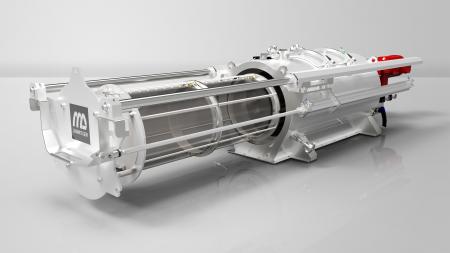Ultrasonically assisted sieving technology of powders, particles and granules.
This article will discuss:
- The principle of sieve
- The optimal functioning of the sieve deck
- The use of ultrasonication
The experts at Dinnissen Process Technology are available to answer all your questions:
Get in touch with Juul Jenneskens 077 467 3555
The principle of sieve
A sieve is a tool used to separate a mixture of powders, particles or granules based on grain size. Screens can also be used to separate solid particles from liquids. The separating effect of a sieve is based on a plate provided with holes of one diameter. From a mixture of large and small particles deposited on the sieve plate, the small particles will pass through the holes in the sieve plate and the large particles will be retained by the sieve plate. What does or does not pass through the sieve plate is sorted according to the size of particles that are larger or smaller than the openings in the sieve plate.
Optimal operation of the sieve deck
Various types of screening machines are used in the industry, a number of examples of which are discussed in the article “Sieving powders, particles and granules”. The screen deck on which the material to be separated is deposited is central to the screening machine. Optimal operation of the screen deck depends on various things. These include the properties of the materials to be separated, the vibrations imparted to the screen deck and the amount of mixture that is offered per unit of time.
During the sieving process, the perforations may become partially or completely blocked. As a result, some of the small grains remain on top of the screen deck, together with the coarser components, and the separation is not optimal. Also, due to the physical properties of the grains in the mixture, small particles can remain between the coarser particles. Think in particular of the shape of grains and the cohesion between the particles. Ultrasonic sieving is particularly suitable for screening mixtures consisting of small particles in the range of 20 to 1000 μm.

Sieve machine which can be drive out
With the help of high-frequency vibrations it is possible to achieve an even more optimal sieving result. especially for the sieving of small particles, this technique provides a high efficiency
The use of ultrasonication
The vibrations imparted to a screen deck usually have a relatively low frequency and a high amplitude. This is necessary to give the grains in the mixture sufficient mobility and to ensure that, in particular the smaller particles, move towards the screen deck at a sufficient speed.
By adding ultrasonic vibrations to the screen deck, a more even movement of the screen deck is created, which ensures a better transport of the grains. These ultrasonic vibrations also contribute to the smaller particles passing through the perforations of the screen deck more easily and experiencing less friction. Practice shows that applying this technique reduces the risk of blockages occurring.
The vibrations are applied by means of an ultrasonic generator that transmits high-frequency vibrations to the screen deck via a rod or ring resonator. Because the intensity of the vibrations in the screen deck decreases squarely with distance, an ultrasonic generator with sufficient power must be used. Furthermore, the correct resonator must be chosen. For rectangular screen decks, you can choose from one or more rod resonators and for round screen decks a ring resonator is chosen. Obviously, the location of the resonator must be such that the vibrations reach all points of the screen deck with sufficient intensity and there must be a good mounting to guarantee the transmission of vibrations.
